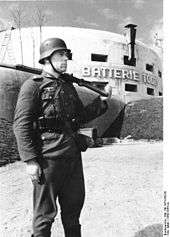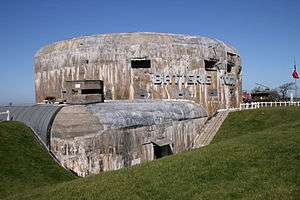Todt Battery
| Todt Battery | |
|---|---|
| Part of the Atlantic Wall | |
| Haringzelle, Audinghen, Pas de Calais, France | |
|
The Todt Battery in 2008 | |
|
Kriegsmarine Ensign | |
| Site information | |
| Open to the public | One casemate is open to the public |
| Condition | Four casemates, in varied condition |
| Site history | |
| Built | 1942 |
| Built by | Organisation Todt |
| In use | 1942-44 |
| Materials | Concrete and steel |
| Battles/wars | Operation Undergo |
| Garrison information | |
| Garrison |
|
The Todt Battery is a battery of coastal artillery built by the Germans in World War II, located in the hamlet of Haringzelle, Audinghen, near Cape Gris Nez, Pas de Calais, France. It was one of the most important coastal fortifications of the Atlantic Wall, and consisted of four 380 millimetres (15 in) calibre Krupp guns with a range up to 55.7 kilometres (34.6 mi), capable of reaching the British coast, and each protected by a bunker of reinforced concrete.
History
The battery fired its first shell on 20 January 1942, although it was only officially opened in February 1942 in the presence of high Kriegsmarine dignitaries. Originally to be called Siegfried Battery, it was renamed in honour of the German engineer Fritz Todt, creator of the Todt Organisation and responsible for the construction of the Atlantic Wall, who died in a plane crash days before the battery's inauguration.
The battery was taken by Anglo-Canadian troops in September 1944, after an intense aerial bombardment, as part of Operation Undergo.
Museum
One of the four casemates now houses a museum about World War II, Musée du Mur de l'Atlantique. The exhibits include military hardware, including, outside, one of two surviving Krupp K5 artillery rail-mounted cannon.
Gallery
 A German soldier at the Todt Battery during World War II
A German soldier at the Todt Battery during World War II One of the battery's 38 cm guns during World War II.
One of the battery's 38 cm guns during World War II.
%2C_Audinghen_01_09.jpg) K5 28 cm railway gun breech, at the museum.
K5 28 cm railway gun breech, at the museum. Another view of the Todt Battery
Another view of the Todt Battery Bunker in 1993.
Bunker in 1993. Bunker housing the museum.
Bunker housing the museum. Diorama showing the battery's four bunkers.
Diorama showing the battery's four bunkers.
References
Notes
Bibliography
- This article was created from the translation of the article Batterie Todt the French Wikipedia, licensed under the Creative Commons Attribution Share Alike 3.0 Unported and free documentation license GNU.
External links
Coordinates: 50°50′39″N 1°36′00″E / 50.8443°N 1.5999°E

.svg.png)
.svg.png)